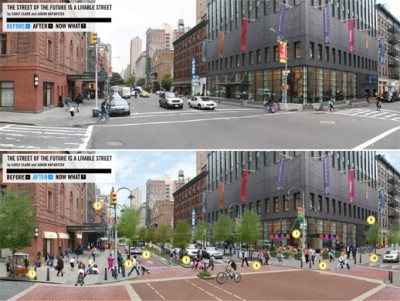GOOD’s ‘complete street’ interactive graphic

What happens when the folks at Good Magazine, where the triple bottom line meets great visual design in a magazine, sets their sights on livable streets? You get The Street of the Future is a Livable Street: How to overhaul a Manhattan intersection interactive graphic, with before and after shots. In partnership with the Livable Streets Initiative (a livable streets social network), they illustrate what is known as a complete street that accommodates pedestrians, bicyclists, motorists and public transport alike.
The ten key ‘complete street’ elements that they list:
1. Street vendors – help make streets into destinations.
2. Pedestrian street lamps – people need lighting at least as much as cars.
3. Curb extensions or bulb-outs – narrows the street at crosswalks.
4. Dedicated bus lanes – allows buses to be as efficient as light rail.
5. Dedicated bike lanes – allows bikes to be as efficient as well.
6. Raised, textured sidewalks – huge aesthetic difference, and clear distinction as a pedestrian-first zone.
7. Traffic lights with a leading pedestrian interval – gives pedestrians a headstart before cars start turning into their lane.
8. Bollards – Non-obtrusive pedestrian protectors.
9. Street trees and plantings – arguably the biggest aesthetic enhancer for any street.
10. Speed bump – classic traffic calming.

This dedicated bike lane looks very dangerous as it forces the cyclists to make both right and left turns across other traffic. As a cyclist I would much rather be integrated with traffic in the lane then forced to renegotiate traffic at every intersection. The reality is that all dedicated bike lanes really do is get bikes out of the way of cars, allowing them to proceed at speeds unsafe for the urban environment. If you want a livable street then calm traffic by riding a bike safely and legally integrate with the flow of cars.
I actually agree – which is why I didn’t post anything about ‘complete streets’ previous to this. Personally, I’d rather live/work/shop on a street with narrower lanes, or rather, incomplete streets of just pedestrians and bikes sharing the same path like in the Netherlands, and buses/cars if necessary. The wider the street, the faster people tend to drive.